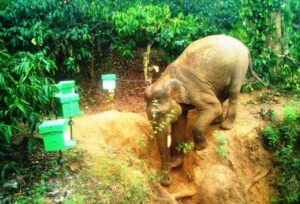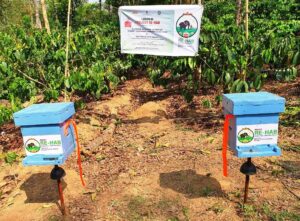By Dominick Rodrigues
Famed boxer Cassius Clay aka Muhammad Ali eulogized the tiny yet mighty bees when he said “I Move like a butterfly, But STING LIKE A BEE.” Today they are in the global limelight for their tiny-yet-mighty-sized presence and noteworthy achievements in giving the environment a helping hand – especially in the spread of verdant forests around the world, which has honoured them with a day of their own.
+World Bee Day+ was celebrated in Goa, India as part of the global celebrations on May 20, 2021, even as billions of the tiny, sweet-gold-bearing, busybody insects continued buzzing their way to environmental glory through pollenising forests, augmenting rural human income and – presently — keeping away marauding elephant from destroying farmlands.
Observing World Bee Day acknowledges the role of bees and other pollinators in the ecosystem and the ICAR- Krishi Vigyan Kendra, North Goa and ICAR-Central Coastal Agricultural Research Institute CARI, Goa, celebrated “World Bee Day” on May 20, 2021 through a one-day programme entitled ‘Augmenting Rural Income: The Beekeeping Way.”
The event, which was organized virtually at ICAR-CCARI Goa, witnessed Dr B L Kashinath, Principal Scientist and Head, KVK, North Goa, highlighting the training program. Dr Lakhan Singh, Director, ICAR-ATARI, Pune, Maharashtra was the Chief Guest of the programme.
Detailing the history of World Bee Day celebrations on May 20 yearly since 2018, Dr Parveen Kumar, Director, ICAR-CCARI, Goa, said the United Nations Council accepted the proposal from Slovenia to celebrate 20th May — birth anniversary of the pioneer of beekeeping Anton Jansa from Slovenia — as World Bee Day.
Highlighting the significance of beekeeping in augmenting the income of farmers, Dr. Lakhan Singh, Director, ICAR-ATARI, Pune, Maharashtra, narrated the numerous success stories of beekeeping including “Madhushakti” — a start-up project initiated by 100 women in Pune over two years and that has now ventured into FPO with branding and marketing of honey and earning additional income alongside farming.
Emphasizing that the KVKs showcase beekeeping by having units on their campus for training and demonstration, Singh also urged for creating network groups of beekeepers and providing them common processing and marketing facilities.
The programme was attended by 52 participants including farmers, officials of Directorate of Agriculture, scientists, subject matter specialists, technical staff of the KVK, North Goa and the ICAR-CCARI, Goa..
The event also witnessed technical session lectures on ‘Scientific Beekeeping for augmenting rural income’ by Mrs. Shishira Uttappa, and ‘Meliponiculture-Beekeeping through Stingless Bees’ by. HRC Prabhu, Subject Matter Specialist (Plant Protection) – which highlighted bee-keeping husbandry practices, benefits, capital requirements, marketing, networking, branding and success stories of beekeeping, and how to get maximum income Meliponiculture, etc.
Bharatpur in Rajasthan has emerged as a major producer of honey over the past few years, with some 3,000 farmers engaged in bee-keeping or apiculture. The mustard flowering season is also the period for honey production in this district, where hundreds of wooden bee-keeping boxes are placed in open patches of land adjoining the fields of marginal farmers — who obtain about 70 per cent of their income from bee-keeping and remaining 30 per cent from agriculture.
However, since 2015-16, a downturn in honey prices due to global overproduction is affecting bee-keepers, who are urging the Government to declare a minimum support price (MSP) for honey and also help establish a proper procurement process.
Apiculture is not an easy trade to be engaged in as bee-keepers face problems due to lack of proper documents, transport etc. Bee boxes need to be transported at night as bees fly out during rising temperatures in the day, while delay at borders and tollbooths results in losses.
Beekeepers feel they could earn additional income if they were provided the required training — with infrastructure and market — for extracting bee pollen, bee venom and royal jelly as these three types have medicinal value and command very high prices in the international market. Bee pollen can also be used as a topping for desserts.
Meanwhile, the KVIC is focusing its attention on promoting Bee-keeping for production of honey – and also defending the crop-growers farms and villagers from raiding elephants , who are attracted to the seasonal flowering crops and fruits. While indulging in their “dining out” expeditions on such farms and causing huge losses, the pachyderms also pose a deadly threat to human lives when the farmers retaliate in different ways that injure them and makes them go on a rampage in those areas.

However, the KVIC’s Project RE-HAB is reported to have begun yielding better results than “Killer Trenches” and “Electric Fences” set up for preventing elephant attacks by state governments through crores of rupees expenditure on such pachyderm-proof barriers.
KVIC’s innovative Project RE-HAB (Reducing Human – Elephant Attacks using Bees), was launched on March 15, 2021 and featured bee boxes being used as a “fence” to prevent elephants from entering human habitation and thus reducing loss of lives and properties. Besides fearing the sting of the honey bees on their eyes and inner side of the trunk, the elephants are more irritated by the bees buzzing around them.
Project RE-HAB — while proving to be an extremely cost-effective and harmless method of reducing human-elephant conflicts — assumes greater significance in the light of the miraculous escape of an elephant that fell into a muddy trench in Siddapura village in Karnataka’s Kodagu district (Coorg) recently.

The viral video of the rescue operation, however, displayed the elephant’s irritation at being placed in this situation and which he displayed by emerging from the trench and bumping his head against the JCB excavator before being shooed away by a bursting firecracker.
This incident witnessed the elephant fortunately escaping without sustaining any serious injury, even as trenches dug by the forest department in elephant-populated areas have led to maximum elephant deaths in forests,
However, the implementation of Project RE-HAB at four locations on the periphery of Nagarhole National Park in Kodagu district of Karnataka has witnessed significant reduction in wild elephant attacks. Night vision cameras installed at these locations have shown a sharp decline in the movement of elephants in human territories – bringing a big relief for locals. The photos revealed the elephants returning to the jungles in fear of encountering the honey bees, while no destruction of crops or properties by elephants has been reported in these areas since the bee boxes were placed there.
Flushed by the Project’s success, Minister for MSME, Nitin Gadkari recently asked the Chief Minister of Jharkhand to replicate Project RE-HAB in the state, while also emphasizing the participation of the Ministries of Agriculture and Environment and Forest in effective implementation of the project across the country.
KVIC Chairman Vinai Kumar Saxena said the KVIC has decided to replicate Project RE-HAB in other elephant-affected states and also urged the state governments to implement Project RE-HAB for preventing elephant-human conflicts. Besides Karnataka, states like West Bengal, Jharkhand, Odisha, Chhattisgarh, Assam, Tamil Nadu and Kerala are severely affected by wild elephant attacks.
“Crores of rupees are spent annually on digging trenches, erecting rail fencing and spiked pillars, putting up electric fences and electric wire curtains to keep elephants away from human territories,” Saxena said noting that all these efforts failed and also ended up killing more elephants in the most tragic ways that were highlighted in incidents of a large number of elephants — particularly the calves – dying after falling in these trenches.
“Project RE-HAB, on the other hand, is cost-effective and providing multi-pronged benefits while causing no harm to the elephants. This will reduce human-elephant conflicts, increase farmers’ income through beekeeping, address climate change, regenerate forest cover and ensure food security for wild animals in their natural habitats,” he added.






